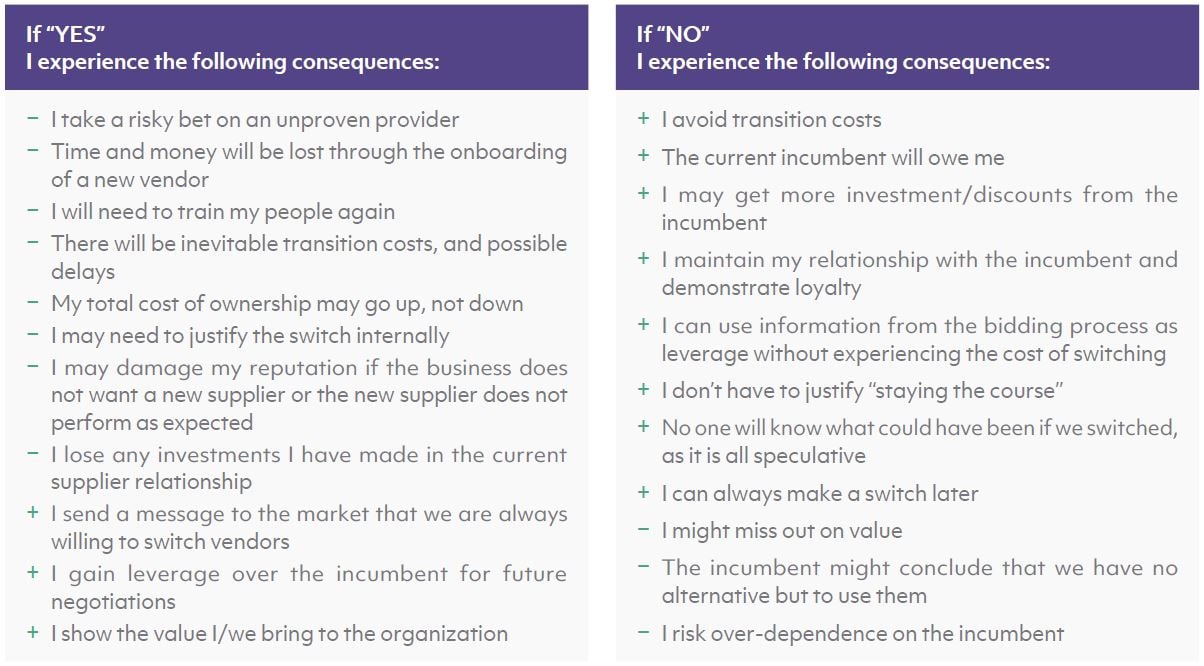
When trying to grow your market share by challenging a potential customer’s existing provider/solution, their objection may not always be about you or your solution, but rather the risk that comes with it. The customer has likely already developed processes and tools to enable it to work effectively with the incumbent. They probably have developed and validated benchmarks on quality and performance. They also know the downsides of working with the incumbent. Even if you have a prior commercial relationship, your company, on the other hand, may be a big unknown.
So when you are trying to dislodge an incumbent, the choice you are presenting to the customer may not be as simple as a different set of products or services at different prices. It may help to put yourself in your customer’s shoes and understand the choice they may see. When presented with a new alternative, the customer might frame their choice as: “Shall I today take a huge risk and abandon my current partner who delivers known value and who we know how to work with?”
We can imagine that they might consider both the pros and cons of saying “yes” to such a question, as well as the pros and cons of saying “no” to the question. This might lead to the following calculus:

If the customer’s analysis were to be along these lines, it is easily understandable why they might be cool to your proposal. here are many more positive consequences to saying “no” to you than there are benefits to saying “yes.” Your central challenge, then, is to tackle head-on the customer’s way of seeing things in order to change a current “no” to a future “yes”.
Broadly speaking, there are three ways to do this. The first is to make “yes” seem more attractive by showing them they would not likely experience the downsides that they think they would. The second is to make their “BATNA” (Best Alternative To Negotiated Agreement) of saying “no” look less attractive. The third is to reshape the substance of your proposal to make it a more compelling offer that better addresses the needs that they now perceive to be unmet.
Demonstrate that the downsides of saying “yes” to your existing proposal would not materialize
Think through, from your potential customer’s perspective, each of the negative consequences of saying, “yes” to your proposal and try to come up with clear arguments that address the concerns that sit beneath these consequences. For example, if you think the customer is concerned that the transition costs are too high, seek to demonstrate to the client that the costs of transition would pay for themselves through other savings, such as efficiencies gained through the use of your product or solution. Perhaps you can provide information about average transition costs and timelines, typical training requirements, and so on, based on your other account relationships.
One of our clients in the manufacturing space recently did a great job of mapping out the details of the migration path to implementing their new solution, and shared client testimonials that directly spoke to the ease of migrating from the legacy platforms to their new technology.
The point here is to be as specific and complete as possible. This is about moving beyond the stock arguments to really dig in and address the underlying concerns that are stopping this customer from getting comfortable with the idea of a switch.
Demonstrate that the upside of saying “no” may not be as great as they think
Sometimes it may be necessary to do a little “reality testing” of the customer’s BATNA. Often this may involve bringing in other influencers or stakeholders with a broader view of the buying organization’s interests.
For example, in the case of a pharmaceutical company that had a product which would shorten hospital stays significantly, if the decision-maker is the pharmacy director seeking to keep drug costs down, saying “no” to the new product is a clear cost saver. However, from the CFO’s point of view, shortening hospital stays increases the number of patients the hospital can treat and decreases their costs significantly — and once that CFO weighs in on the pharmacy director’s choice, “no” starts to sound much less attractive.
Often “no” feels easy because that is preserving the status quo, and doing nothing on any given day feels comfortable and painless. You may need to demonstrate to the potential customer, in a credible way, how failing to act today may lead to the loss of a real business opportunity that has tangiblecosts. This is easiest when there is a credible “deadline” driven by external forces (e.g., “if we don’t get started this week, we cannot have the new system in place by year-end, and you will lose all the potential tax benefits for this fiscal year”). Real deadlines change the choice in a way that can make a “no” today look less attractive.
Restructure your proposal to better address their underlying needs and concerns
Sometimes you will find that the downsides of a “yes” to your current proposal are valid concerns that the customer perceives to be unaddressed. Perhaps your product is new and they will be one of the first customers to try it out. For example, if the underlying concern is about transition costs and you believe that your current proposal is not strong enough to win them over, perhaps you propose a trial period or you pilot the solution in one part of the customer’s company. If the concern is about credibility with internal end-users, you could suggest a risk-sharing model where price is based on performance or yield. If they have a concern about the time and money required to train their people, perhaps you can offer enhanced service to address this. The key point is that this approach allows you to target your solutions more effectively — instead of trying different approaches in a scattershot, you are carefully analyzing the need and coming up with a precise way of dealing with it, thereby protecting your bottom line.
Successfully challenging an incumbent requires a thorough understanding of the customer’s underlying needs and concerns — which in turn requires persistence, patience, and open inquiry. Demonstrating that you can respond directly to these concerns, either by providing the customer with a new frame on their concerns or concrete new proposals, is likely to help you get them over the finish line.
.png?width=512&height=130&name=vantage-logo(2).png)



